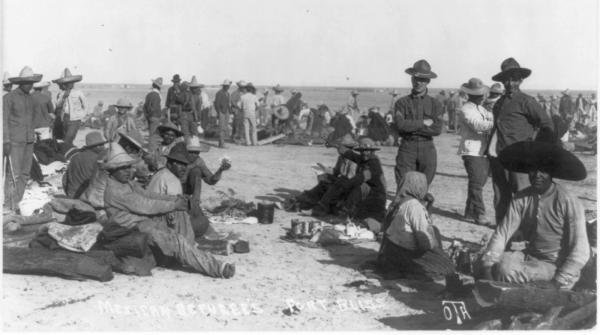Bob Avakian has written that one of three things that has “to happen in order for there to be real and lasting change for the better: People have to fully confront the actual history of this country and its role in the world up to today, and the terrible consequences of this.” (See “3 Things that have to happen in order for there to be real and lasting change for the better.”)
In that light, and in that spirit, “American Crime” is a regular feature of revcom.us. Each installment focuses on one of the 100 worst crimes committed by the U.S. rulers—out of countless bloody crimes they have carried out against people around the world, from the founding of the U.S. to the present day.
See all the articles in this series.


THE CRIME
On November 3, 1910, Antonio Rodríguez was dragged from his job by a posse of armed white men. Without any evidence, they accused Antonio, a 20-year-old ranch worker from a small town in northern Mexico, of murdering a white woman on a nearby farm a day earlier. They beat him and put him in the jail at nearby Rock Springs, Texas. On November 4, in broad daylight, a mob pulled Antonio Rodríguez from his cell and burned him at the stake. No charges were filed against any of the murderers.
Several months later, 14-year-old Antonio Gómez was quietly whittling a piece of wood in Thorndale, Texas. A group of men who had been drinking in a saloon suddenly burst into the street, grabbed him, threw him on the ground, and assaulted him, one man whipping him with the branch he had been carving. Antonio had also been accused of assaulting a white woman. Antonio slashed out with the knife in his hand, fatally stabbing one of his assailants. The chief constable in Thorndale put a chain around Antonio’s neck. A white mob attacked Antonio Gómez and dragged him across town. They repeatedly kicked him in the head and hanged him from a ladder and telephone pole in the middle of Thorndale. Four of these brazen killers did go on trial, and a year later none were convicted.
The lynchings of Antonio Gómez and Antonio Rodríguez were highly publicized in the U.S. and Mexico. Students across Mexico staged angry anti-American demonstrations, many of them “spitting on and burning American flags.” But the outcomes of the two incidents established a precedent as Texas entered a tumultuous decade. As author Nicholas Villanueva summed up, they meant that white men would not be punished for lynching Mexicans in Texas, even in the rare instances when they were actually charged. They ushered in a decade of horrific violence against people of Mexican descent in Texas.


The bodies of three Mexicans who were lynched in Texas, 1915, are dragged to town by three Texas rangers.
From the time white Americans began bringing slaves into what was then the Mexican territory of Texas, violence against Mexicans was foundational to U.S. westward expansion. Hundreds of Mexican people were lynched across what had been Mexico but became the U.S. Southwest, in mining camps, on ranches, in small towns, and in cities like Los Angeles and Albuquerque.
This horrific violence escalated dramatically in the years 1910-1920—a period that became known as "La Matanza" (Spanish for "the Massacre"). In Texas, more Mexicans were lynched—murdered without due process or any legal procedure at all for the victims, and no charges or investigations against the perpetrators—during that decade than during the previous four decades combined.
Hundreds, perhaps thousands of people of Mexican descent were killed in South Texas in those years. The fact that estimates of the number of deaths varies is itself an indication of this society’s contempt for Mexican life. In many cases, no official records were kept. Also, because the deeply racist legal system in Texas didn’t classify Mexican people as either white or Black—the two categories that could be recorded—the number of lynched Mexican people is uncertain. The organization Death Penalty Information Center summed up that border historians William D. Carrigan and Clive Webb estimate that in Texas “more than 5,000 Mexican Americans were murdered between 1910 and 1920. That wave of terror included numerous extra-judicial lynchings and murders of Mexican Americans by vigilantes, local law-enforcement officers, and Texas Rangers.”
Mexican people were hanged, doused in gasoline and burned, shot, beaten, dragged by cars and horses. Women were raped. People’s homes, barns, and fields were burned, their property and livestock destroyed or stolen. Their corpses were left to rot in the sun, hanging from trees or lying on the ground, as a “lesson” to others of the fate that could await them. The San Antonio Express reported that “finding the bodies of dead Mexicans has become so commonplace that it creates little or no interest.”
The killers often posed to have their pictures taken with those they had murdered, displayed like animals. These pictures frequently appeared in local papers. And, as the Austin American-Statesman wrote about these barbaric incidents, “... yes, people did send postcards of these lynchings throughout the early 20th century.”
THE ALIBI
Mexican people were routinely treated and described as animalistic subhumans, people against whom violence was legitimate, and often necessary. A passage in the Galveston Daily News that described Mexican “peons” as “prone to violence, disease, and alcoholism” was typical. A San Antonio paper wrote that Mexican men “have no more control over their passions than an angry beast, and in their ignorance are just as unreasonable.”
People of Mexican descent were accused of violent crimes like theft, rape, robbery, assault, and murder in papers across Texas on a daily basis, for years. Villanueva pointed out that “[white] mobs believed they were policing the region and targeted Mexicans for suspected crimes of murder and theft more than any other reason.” Violence against Mexican people, whether by vigilantes or official enforcers, was praised, and its perpetrators upheld as heroic.
The Jim Crow system of brutal segregation against Black people was well established in Texas, and upheld by U.S. laws. It had not applied, legally, to Mexican people. But during these years the degraded status of Mexican people solidified in Texas law and culture, and became embedded in its institutions. Signs reading “No Dogs or Mexicans Allowed” became common, and remained so through the 1950s.


Electrically charged fence detains Mexican refugee children, Fort Bliss, Texas, 1914.
THE ACTUAL MOTIVES
Big changes were underway in the Texas border regions in the early 20th century. Large numbers of white people were moving into areas that had long been populated by people of Mexican descent. They saw an area with great potential for ranching, farming, mining, and industry. They also saw that legal ownership of that land was in the hands of Spanish-speaking people, many of whom had lived there for generations. The arrival of railroads and the expansion of large-scale irrigation in the early 1900s made the fertile land more productive, and costlier. Many of the Mexican people were unable to pay rising taxes to keep the land. Ownership records maintained in Spanish were challenged in court by whites, almost always successfully. Sometimes, historian Benjamin Heber Johnson wrote, white ranchers “resorted to the simple expedient of occupying a desired tract and violently expelling previous occupants.”
The result of this dispossession was catastrophic for the people who had lived there. Between 1900 and 1910, more than 187,000 acres of land transferred from ownership by Spanish-speaking people of Mexican descent to whites in just two South Texas counties that became, and remain, a mainstay of capitalist agricultural production. Many of those who lost their land ended up working on it, at meager wages, for its new owners.
Also, Mexico was in the throes of an enormous revolution during the years 1910-1920. It is not in the scope of this article to analyze that, but the U.S. capitalists thought their interests within Mexico and within the entire region they consider their “backyard” were gravely threatened. They were determined to protect and advance these interests. They wanted to impose their will on Mexico, and enforce a white supremacist, pro-U.S. “stability” in the border regions.
There were numerous U.S. military “incursions” into Mexico in these years. In 1914, U.S. President Wilson asked for and got congressional approval for an armed invasion of Mexico. U.S. naval forces bombed the port city of Veracruz, and began a six-month military occupation. U.S. Army forces invaded Mexico in 1916 in a futile search for rebel leader Pancho Villa.
Upheaval in Mexico compelled tens of thousands to leave their homes, and many crossed the Rio Grande River into Texas. Political leaders in the U.S. and Texas were also determined to prevent the “contagion” of rebellion and revolution from gaining momentum among Mexican people in Texas. In 1914, the U.S. Army established a “detention center” that held about 5,300 Mexican refugees at Fort Bliss, in El Paso. By August 1, 1916, 112,000 troops were stationed on the border from Brownsville, Texas, to Douglas, Arizona.


June 18, 1916, U.S. President Woodrow Wilson ordered 110,000 National Guardsmen from state militias to the border for patrol duty. Above, troops in Brownsville, Texas.
Army and National Guard troops did not primarily participate in the bloody repression underway within Texas. But they presided over a situation that gave almost free reign to years of sustained violence against people of Mexican descent.

THE CRIMINALS
U.S. presidents Taft and Wilson, who both sent tens of thousands of troops to the border, and in Wilson’s case, to invade Mexico.
Texas governors Colquitt, Ferguson, and Hobby, who unleashed the murderous Texas Rangers on the people of South Texas. Subsequent Texas governors sealed records of state and federal investigations into the atrocities for decades.
Murderous Texas Rangers, local police and sheriffs, and vigilante mobs led by “prominent citizens,” who all engaged in ruthless, racist violence with impunity.
The U.S. Supreme Court, which refused to hear the one case of a Mexican man being lynched that came before it during this period, signaling that at no level of government would anyone be held accountable for the genocidal onslaught underway.
Newspaper editors and journalists from Galveston to El Paso, who steadily whipped up a climate of racist hatred that fueled the convulsions of violence.


Fort Bliss, Texas, 1912. U.S. corporal guarding Mexican refugees held in detention camp.
ONGOING CRIMES
The U.S.-Mexico border is a blood-soaked fault line that concentrates great crimes of U.S. imperialism. Thousands of people—including infants and young children—have died trying to cross it, many of them lost and their corpses ravaged in the deserts, plains, rivers, and mountains. Hundreds of thousands have been snared by the Border Patrol and sent back to the U.S.-created hells they tried to flee. This border is a militarized zone of high-tech weaponry, razor wire fences, heavily armed vigilante squads, and brutal federal agents. It is home to several concentration camps, including for children. It is a manifestation of everything that is putrid and unacceptable about this system.
Watch BA’s whole speech, Why We Need An Actual Revolution And How We Can Really Make Revolution
